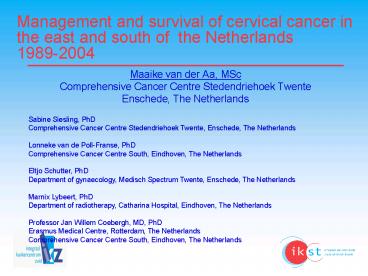Maaike van der Aa, MSc - PowerPoint PPT Presentation
1 / 12
Title:
Maaike van der Aa, MSc
Description:
Department of gynaecology, Medisch Spectrum Twente, Enschede, The Netherlands ... Working group Oncologic Gynaecology 1990. Clinical alerts National Cancer ... – PowerPoint PPT presentation
Number of Views:48
Avg rating:3.0/5.0
Title: Maaike van der Aa, MSc
1
Management and survival of cervical cancer in the
east and south of the Netherlands 1989-2004
- Maaike van der Aa, MSc
- Comprehensive Cancer Centre Stedendriehoek Twente
- Enschede, The Netherlands
Sabine Siesling, PhD Comprehensive Cancer Centre
Stedendriehoek Twente, Enschede, The
Netherlands Lonneke van de Poll-Franse,
PhD Comprehensive Cancer Centre South, Eindhoven,
The Netherlands Eltjo Schutter, PhD Department
of gynaecology, Medisch Spectrum Twente,
Enschede, The Netherlands Marnix Lybeert,
PhD Department of radiotherapy, Catharina
Hospital, Eindhoven, The Netherlands Professor
Jan Willem Coebergh, MD, PhD Erasmus Medical
Centre, Rotterdam, The Netherlands Comprehensive
Cancer Centre South, Eindhoven, The Netherlands
2
Background
- Working group Oncologic Gynaecology 1990
- Clinical alerts National Cancer Institute 1999
- National guidelines www.oncoline.nl
- Hysterectomy or radiotherapy for low stage (FIGO
IB-IIA) cervical cancer - Radiotherapy combined with hyperthermia or
chemoradiation for locally advanced cervical
cancer (FIGO IIB-IVA) - New diagnostic procedures (CT, MRI)
- Nationwide screening programme in 1988
- Expectation more tumours with lower stages and
increasing survival rates
3
Aims
- To describe changes and variation in treatment
and survival in cervical cancer in the region of
the Comprehensive Cancer Centre Stedendriehoek
Twente (CCCST) and in the region of the
Comprehensive Cancer Centre South (CCCS) in the
period 1989-2004 and relate this to guideline
adherence
4
Methods
- 1954 cervical cancer cases CCCST and CCCS
- Analyses concerning treatment period 1989-2004
- Analyses concerning survival 1989-2002, n1736
- Patient characteristics
- Tumour characteristics (FIGO stage derived from
cTNM) - Treatment data
- Follow-up data
5
Results (trends in stage)
- No time-dependent changes in lymph node status
- No changes in stage distribution across time
periods - Older patients more higher stage tumours than
younger patients (plt0.05)
6
Results (trends in treatment FIGO IB-IIA)
- 730 patients
- In the whole period, 91 treated according to the
national guidelines - 77 received hysterectomy, 14 received
radiotherapy - Adjuvant radiotherapy after hysterectomy was
given to 72 of patients with positive lymph
nodes and 47 with negative lymph nodes - Proportion of patients treated according to the
national guidelines decreased (plt0.05)
7
Results (trends in treatment FIGO IIB-IVA)
- 527 patients
- In the whole period, 76 treated according to the
national guidelines - No changes across different time periods
- In the CCCST region more patients treated
according to guidelines (plt0.05) in the CCCS
region 14 received hysterectomy with adjuvant
radiotherapy - Chemoradiation was less given to older patients
than to younger patients (plt0.05)
8
Results (survival FIGO IB-IIA)
9
Results (survival FIGO IB-IIA)
10
Results (survival FIGO IIB-IVA)
11
Results (survival FIGO IIB-IVA)
12
Conclusion
- National guidelines better implemented for
treatment of FIGO stages IB-IIA than for FIGO
stages IIB-IVA. - National guidelines were not always followed.
- Attention has to be paid to the role of adjuvant
radiotherapy because survival benefits could not
be proven so far. - Individual patient and tumour characteristics
remain clear prognostic factors.
Thank you for your attention!































